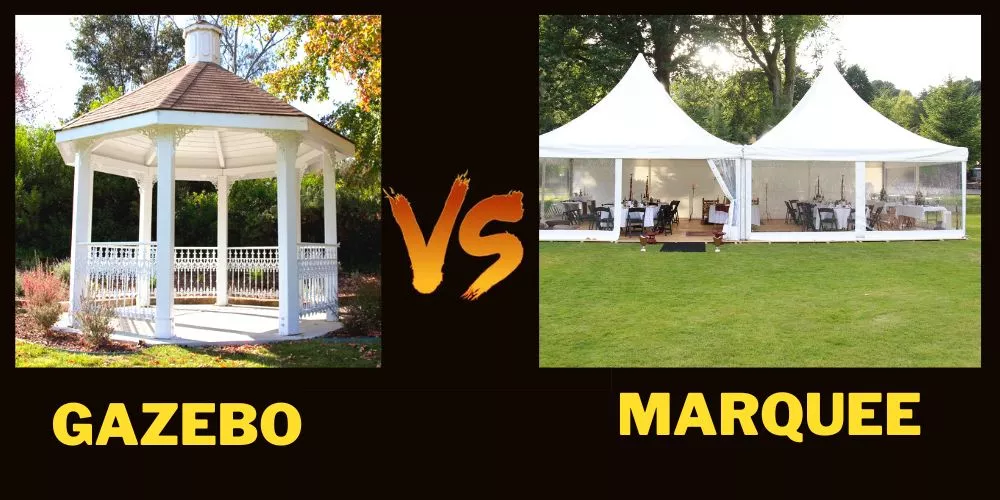When it comes to enhancing your outdoor living space, two popular options stand out: gazebos and pavilions. These structures not only provide shade and protection but also elevate the aesthetics of your backyard.
Both of these share a lot of similarities. So many that it’s often difficult to tell them apart, but I will still give this gazebo vs pavilion thing a try.
Traditionally, pavilions were used to host larger parties or events such as weddings, funerals, sports, etc. They were built to accommodate the free flowing of people hence the open sides. At the same time, the traditional gazebo was designed to be much smaller and more intimate.
They were more suited for gardens or sitting areas in a park. They were generally closed with sides to help mitigate the variating weather. Fast forward to today, and the traditional usage has been muddled a bit.
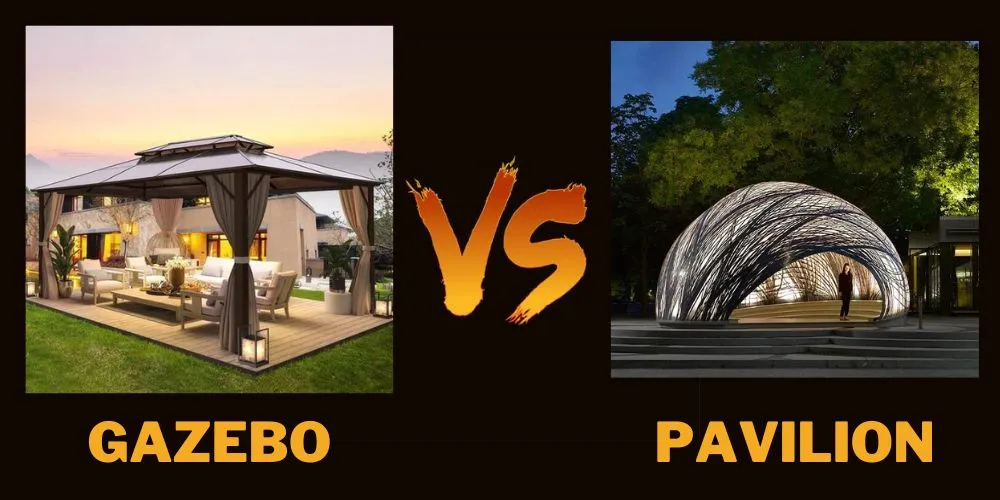
In this article, we’ll go through all the differences and similarities in much more detail to help distinguish between the two structures with relative ease.
What is a Gazebo?
The definition of a gazebo has been somewhat distorted in recent years. Structures have been engineered for convenience and updated aesthetics.
However, the principle has always remained true through the ages. A traditional gazebo is generally a smaller, more intimate structure.
It contains a tiered roof to assist with the runoff of rainwater. The roof would generally be made using shingles, shakes, or even metal when the wood wasn’t available.
The support beams and fence type railings were built using wood, plastic, and other composite materials.
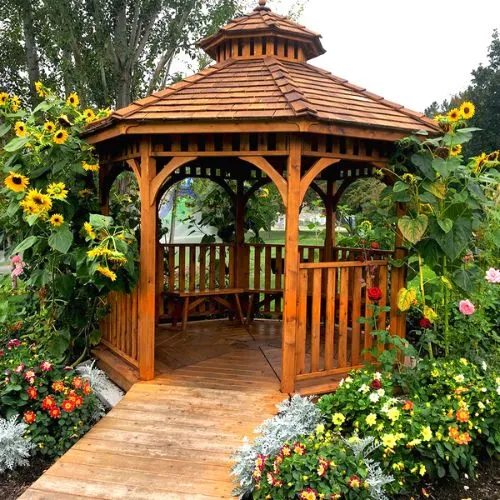
These days, other materials, such as galvanized steel, have been introduced as they can be manufactured at scale. Furthermore, gazebos have been semi rebranded as portable or pop up structures that can be used in various outdoor settings.
They are pretty much glorified tent that allows its user the freedom of movement. These outdoor settings include weddings, camping, at the beach, etc. The newer, updated versions are usually made with fabrics and light duty metals such as aluminum which can be erected using buttons and tie off ropes.
What is a Pavilion?
Much like gazebos, the humble pavilion has also transformed over the ages. Pavilions were designed as garden extensions so plants could have respite from harder weather elements.
They were also built as a space where larger groups of people could gather outside for marquee events all in one place. Such events included weddings, sports days, business meets, art exhibitions, etc.
The structure allowed ample air and light and allowed guests to move freely without any restrictions from enclosed walls or fencing.
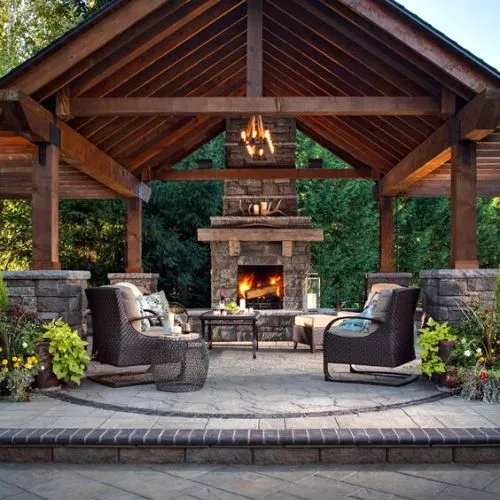
Furthermore, pavilions didn’t require a firm base such as concrete to build on. Their support beams were installed directly into the ground at a specific depth. Initially, the ground covering was grass or gravel, but the idea of a dry walkway was introduced, and bases such as wooden decks and flooring were introduced.
As time progressed, more structures were designed to help us adapt to our lifestyles and surroundings. This is where newer designs like pergolas were built. The main difference between pavilions and pergolas is their roof. The roof of a pavilion is closed and covered, whereas a pergola has an open, slatted roof.
Gazebo vs Pavilion: Similarities and Differences
The differences weren’t at all questionable in the dawn of the much touted outdoor undercover areas we know today. They had their specific purposes and features, which enabled them to be easily distinguished. As it sits now, though, there is a lot of confusion surrounding the discrepancies between gazebos and pavilions.
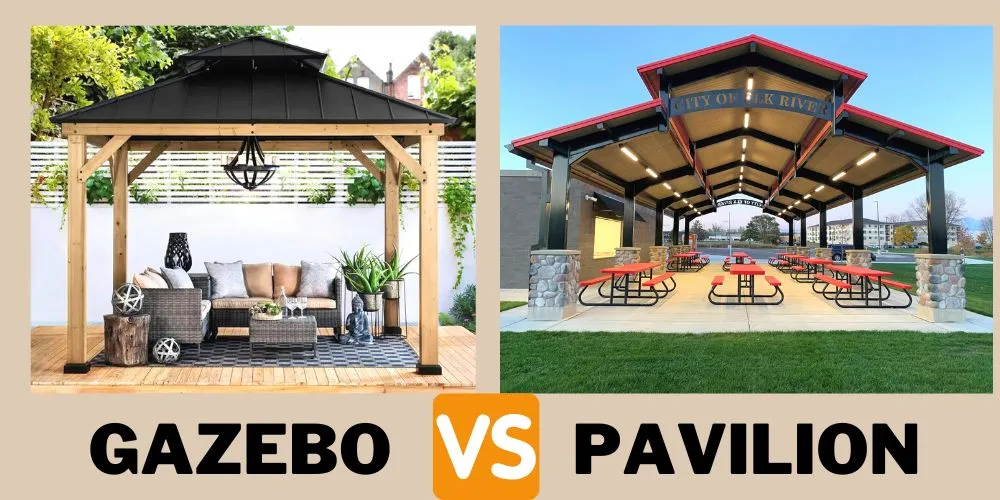
They offer covered protection from the elements, and they both have that same contemporary era vibe. No wonder they are often mistaken. Furthermore, other structures like pergolas and carports were created, which made it even more difficult to tell the difference.
Let’s look at the major similarities and differences between the gazebo and pavilion in detail. This will help to give us a better understanding and help us to easily distinguish between the two.
Similarities
The gazebo and pavilion are the closest relatives compared to other outdoor structures like pergolas and carports. The major similarities include the following:
1. Structure
The most common parallel between both gazebos and pavilions is their overall structure. They are both open-air buildings with vertical support columns and finished with a solid roof.
2. Weather Protection
Both structures are designed in theory to protect their users from varying weather elements, including rain, snow, sun, etc. The slightly higher tiered roof of the gazebo is more beneficial for water and snow runoff. So, in theory, shelter was the ultimate goal when the plans for these buildings were created.

Differences
The differences are subtle but also quite deliberate when looking in from a construction point of view. They include:
1. Size
The gazebo was designed to be an added feature that would subtly blend into a garden. It was meant to be noticeable but not overbearing. Therefore, the size is much smaller and more intimate than a pavilion. A gazebo usually shelters a small handful of people with a bench or two for relaxing and taking in the scenery.
Whereas a pavilion is much larger. Its intention is for a larger group of people. For example, You may notice at sports events that there is a ‘Famous name sports pavilion’ that onlookers use to watch the sport. Or even a wedding that is held under an open air pavilion.
2. Flooring
It’s common for a gazebo to have the floor built into the structure. Or the floor was laid first, and the gazebo frame was bolted on when it was being built. The flooring would usually be made from wood or concrete.
Whereas a pavilion would traditionally be built over grass or gravel. The flooring may even be added later on after the build is complete. Some pavilions have pavers or stonework added underneath, depending on the style the owner wishes to present.
3. Screens
In most cases, a gazebo will have some kind of wall or screening. This can be in the form of a waist high fence module or even a floor to roof slatted wall. Both can offer a sideward breeze while introducing more privacy if or when required. Of course, some gazebos can have completely open sides as well.
A traditional pavilion will almost always be open around the sides. However, it is becoming increasingly common these days to introduce moveable glass panels that can lock into place and completely enclose a pavilion. It all depends on the owner. New tweaks can be added to improve the overall experience as innovation improves.
4. Roofs
The roof of a gazebo was originally designed to be either flat or tiered. The step up in height could be used as a means of air circulation. It could help to air out any excess hot air and improve the overall condition of the air.

Whereas the pavilion roof is more pitched. How a larger structure is built will often need the pitch to help spread the weight load. A lot more effort and materials are involved in trying to add tiers to a larger area structure. Therefore, the simplest and most effective method is to add a pitch. This slant in the roof is great for the runoff of rain and snow.
5. Cost and Maintenance
Considering the cost and maintenance factor, gazebos and pavilions can differ greatly. Gazebos tend to be more cost-effective compared to pavilions, primarily due to their smaller size and simpler construction.
The cost of a gazebo can vary depending on the material chosen, with wood gazebos generally being pricier than vinyl or metal options. Pavilions, on the other hand, can be more expensive due to their larger size and more intricate construction.
Additionally, pavilions may require a higher degree of maintenance due to their size, as they may require periodic cleaning, painting, or sealing.
6. Customization and Options
Both gazebos and pavilions offer a range of customization options to suit individual preferences. Gazebos can be customized with various features such as screens, benches, lighting, and even built-in audio systems.
Pavilions, on the other hand, boast a more open design, allowing for greater flexibility in terms of layout and usage. They can be customized with additional features such as outdoor kitchens, fireplaces, or even swimming pool enclosures.
The level of customization depends on personal preferences and budget allocation.
You May Also Find Useful: Hardtop vs Soft Top Gazebo
Frequently Asked Questions (FAQs)
Which one is better pavilion or the gazebo?
This can only be answered with a purpose in mind. A gazebo is often much smaller and more intimate. It would suit a garden tucked away in a quiet corner of a park or even in a backyard. A pavilion would suit a larger area with recurring events or guests. This all depends on the owner, though. They are both wonderful structures.
Does a pavilion need a roof?
This question can only be answered by the person(s) responsible for building or acquiring the pavilion. Traditionally, pavilions are built with a roof in mind. They are finished with a solid roof. However, times are changing, and if someone chooses to build a roofless pavilion, then so be it. Although, you would probably then call it a pergola.
Which is more suitable for a small backyard?
Gazebos are generally more suitable for small backyards due to their compact size and versatility. They can be installed in various locations within the backyard, allowing homeowners to create a cozy and private space without occupying too much room.
Conclusion:
Choosing between a gazebo and a pavilion ultimately comes down to your specific needs, budget, and the space available. Gazebos offer a charming and intimate retreat, perfect for small gatherings and personal relaxation.
On the other hand, pavilions excel at providing a larger, covered outdoor living area suitable for hosting events and accommodating a larger number of people.
Consider your desired usage, available space, and personal preferences to select the perfect outdoor structure that will enhance your outdoor living experience for years to come.

